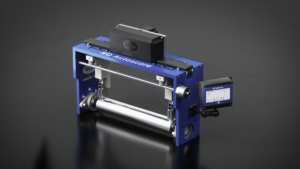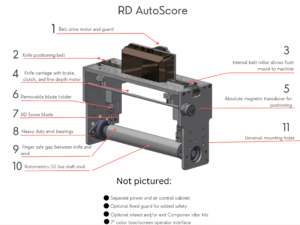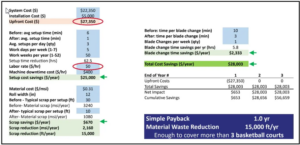Underscoring has always been a manual, trial-and-error process on the web press. But a new product has emerged that enables converters to not only automate the process but also provide access to materials that previously couldn’t be scored.
The breakthrough in scoring capability is the result of the merger between Maxcess and Rotometrics in February 2020. Rotometrics is highly regarded for its die-cutting products and expertise, and Maxcess has a long history of providing end-to-end web handling solutions for the converting industry.
Combining their respective strengths has provided new capabilities and perspectives in automation. The result is the recent launch of RD AutoScore, and the promise of new opportunities for converters and OEMs.

5 steps too many: The dreaded manual underscoring setup process
Underscoring, or backscoring, is the process of cutting through a material’s liner down to the face — while leaving the face intact. Until now, this has been a manual, trial-and-error setup process on the press. Every time a new job is run on a press, operators must:
- Stop the machine
- Reach into the press and adjust the score blade trim position and depth
- Run some material
- Check the underscore result
- Repeat depth adjustment until achieving a successful underscore
“Even with skilled operators, setup of a traditional underscore unit can take 5 to 10 minutes,” says Aaron Powers, Global Product Manager for Maxcess’ Tidland brand.
Those numbers add up over time, but the process results in inefficiencies that extend beyond time. They include:
Damaged score blades. If a blade is adjusted too deep, it will crash against the anvil and damage the blade.
Wasted material. Trial-and-error adjustments result in wasted material, usually 15 to 40 feet per run. This becomes a big issue as material costs get higher.
Labor problems. With a manual process, you must rely on skilled operators. When those operators leave or retire, you have an issue filling their shoes with an unskilled workforce in a tight job market.
New capabilities = dramatic changeover improvements
This inefficient, operational thorn in the side of converters was erased in one fell swoop when Rotometrics merged with Maxcess in 2020.
“Rotometrics brought their know-how on underscoring, and Maxcess has a long history of auto slitter positioning and automation,” says Powers. “We identified the opportunity and created a combined, next-generation product solution.”
RD AutoScore allows you to easily score all liner materials, including PET, enabling you to run faster with less setup time, thanks to:
Automatic depth setting and trim width control. With a touchscreen interface, operators can instantly set the blade position. No need to run materials to check the score depth, just set it and go.
Flexible blade positions anywhere across the web. There are no limitations to where the blades can be positioned along the anvil, enabling center or off-center trim alignment as required by the job.
Built-in job and material libraries. Once you’ve set the blades, the position and cut depth can be saved and quickly accessed by operators for repeatable setup when switching materials or jobs.
Enhanced safety keeps presses running. By removing the need for operators to reach into the knife-zone in the press, sometimes even getting on their hands and knees, RD AutoScore dramatically improves worker safety — which also keeps your presses running.

Those are some of the key efficiency features in RD AutoScore. But how does the product translate into new opportunities?
Run more materials, generate more growth
Powers notes that converters have traditionally avoided underscoring certain materials, such as those with a paper face and filmic liners. If they do opt for these materials, they’re forced to use a through-cut (slit) for trimming edges, and must run presses at slower speeds to ensure the waste matrix doesn’t break while stripping.
The precision of the RD AutoScore allows it to kiss-cut through the liner only, leaving the face intact. You can then strip the matrix after the die-cutting and scoring process.
Because the waste matrix’s outside edges have both liner and face layers, this adds strength and eliminates breakage at higher speeds. It also allows for higher tensions, resulting in improved stripping. “It opens up the potential to run faster,” Powers says.
Results: Big impacts across the board
How do the improvements translate into realized performance gains? Take a look at some of the key results:
Setup times improved from 5 to 10 minutes to less than 1 minute. This is the result of both the automated depth setting and trim width control — as well as access to the stored material and job library.
Elimination of 15 to 40 feet of material scrap per setup. With the precision setup, you instantly remove the typical scrap caused by underscore adjustments when running material during the setup.
Reduction of workplace injuries. Of course, injuries on the press can always occur no matter what level of automation, but removing the manual setup eliminates the safety problem caused by workers reaching into the press or getting on their hands and knees for manual adjustment.
No blades damaged during setup. Operators, especially new ones, frequently damage blade tips through inadvertent anvil crashes. The automated process now eliminates the chance of that occurring.
Training hours eliminated or greatly reduced. Once an operator understands how the touchscreen interface works, a new operator is as skilled as the seasoned veteran. It’s a fact that can’t be overlooked as the older set of operators makes way for a younger generation.
Return on investment in less than a year
With the setup time reduction, reduced blade damage, and material waste savings, the RD AutoScore typically pays for itself in less than one year. The ROI is calculated primarily by reduced downtime for setup and blade changes, and scrap reduction. Here is an example:
“Customers who take advantage of the improved capability to underscore filmic liner materials to run faster see an even more rapid payback,” Powers adds.
How does it fit with your machine?
RD AutoScore is a compact, standalone module that is flexible in its orientation, allowing it to be easily added to a new machine or retrofitted to existing equipment.
“It can drop in between the machine frame using an idler roller location as the fixing point, inside an existing frame cutout, or on top of the frame as space allows. The separate touchscreen is added nearby, in a location convenient for the operator,” says Powers.
